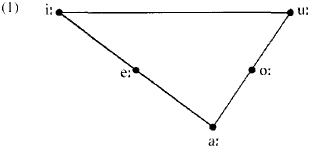No CrossRef data available.
Article contents
Long mid vowels in Attic-Ionic and Cretan1
Published online by Cambridge University Press: 28 February 2013
Extract
§1. Common Greek inherited from proto-Indo-European a simple five vowel system as shown in (1), with one mid vowel on each of the front and back axes. Only the long vowel system is shown here; the short vowel system had the same structure.

The inherited system was inherently stable: there was balance between the short and long vowel systems and between the front and back axes, and with only one mid vowel on each axis, there was no problem of overcrowding. The individual phonemes were, so far as we can tell, optimally distributed in the available phonological space. (The diagram shows the back axis as being shorter than the front, since anatomical constraints mean there is less articulatory space at the back of the mouth; see Laver (1994)272–3).
- Type
- Research Article
- Information
- Copyright
- Copyright © The Author(s). Published online by Cambridge University Press 2006


